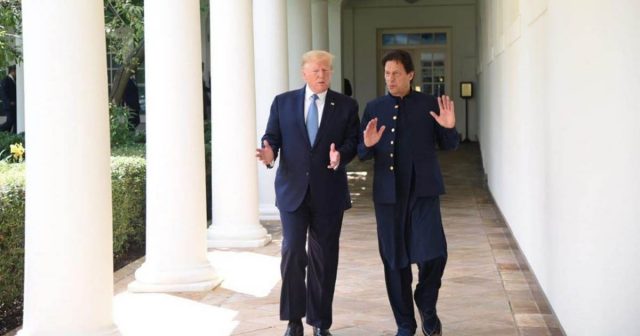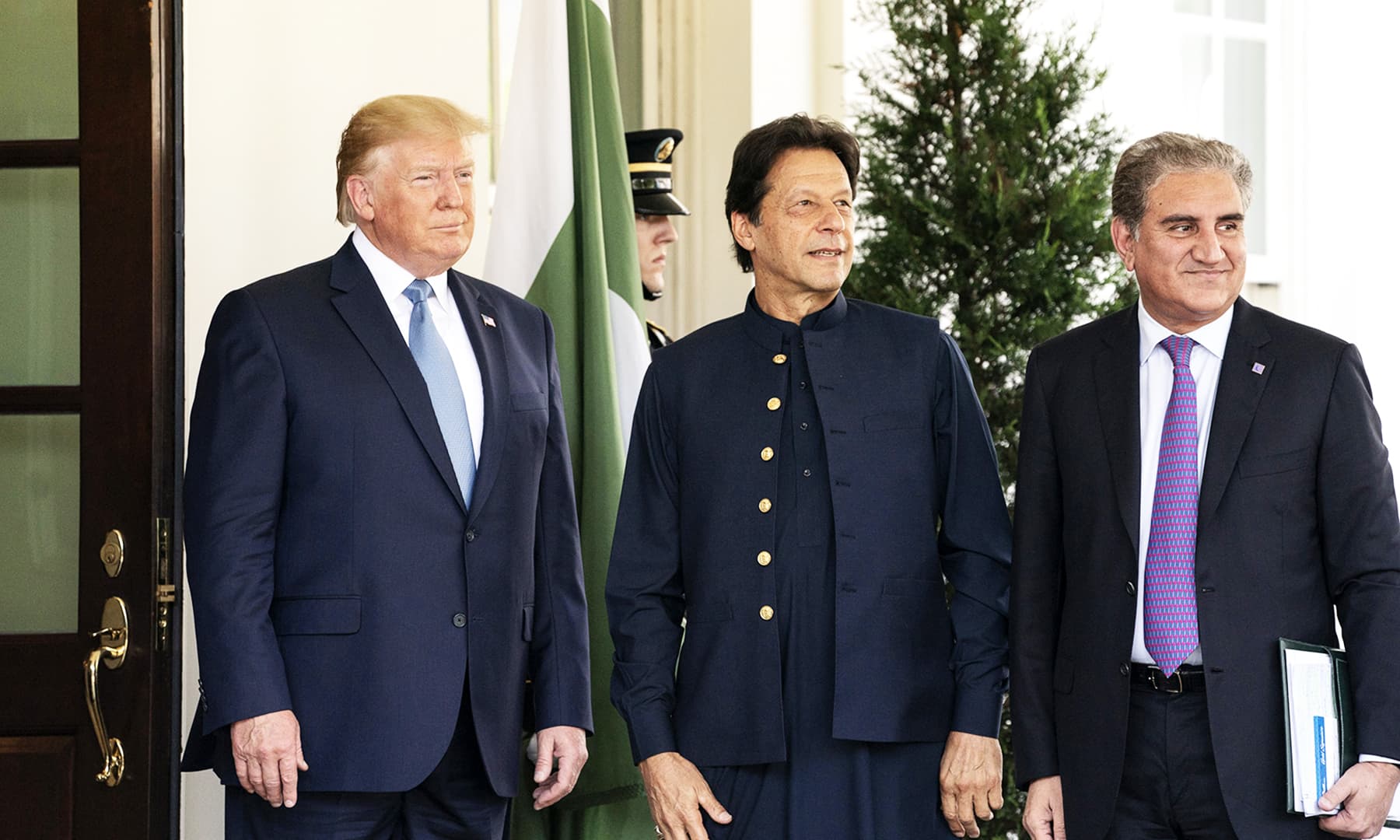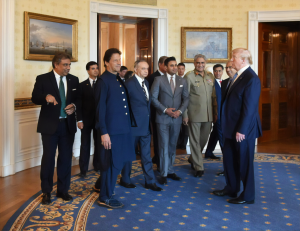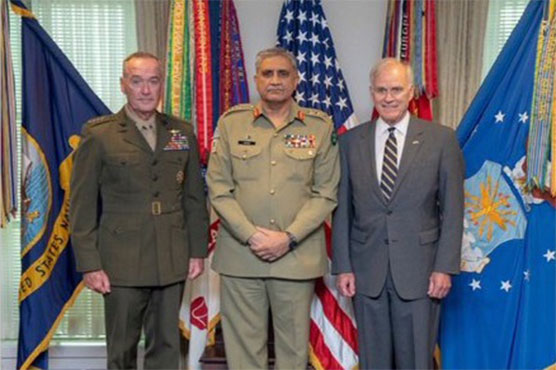Imran Khan made a historic visit to the US and was successful in persuading White House of his commitment towards peace in the region. Washington didn’t ask Islamabad to do more this time but calling this a reversal of the US-Pak relations is far-fetched. There is still much more to do.

Michael Kugelman July 29, 2019
For proponents of the U.S.-Pakistan partnership, there’s much to be heartened about after Prime Minister Imran Khan’s recent visit to Washington.
There were smiles and kind words all around as he met with senior officials from across the U.S. government spectrum, including President Trump. Other members of Khan’s delegation, including Army Chief Qamar Javed Bajwa, met with critical stakeholders as well.
The optics of the trip were extraordinary; from Khan getting feted by a packed room of elected officials on Capitol Hill to General Bajwa’s visit to Arlington National Cemetery to pay homage to U.S. war heroes.
Understandably, optimism broke out in Islamabad following what the Pakistani government rightly proclaimed a successful visit. Upon returning home, a euphoric Khan declared that he felt “not as if I have returned from a foreign trip, but as if I have returned after winning” the cricket World Cup.
U.S.-Pakistan relations have come a long way, especially given their dreadful state during the Trump administration’s early months. Still, it’s important not to overstate the improvements in the relationship. Khan’s visit cemented the two sides’ deepening cooperation in Afghanistan, as Washington rapidly pursues a deal with the Taliban to give President Trump the cover he needs to announce a troop withdrawal.

But beyond Afghanistan, the obstacles to greater cooperation remain considerable. It’s worth examining these obstacles in detail, and also what we can expect this slowly stabilizing but a still-volatile partnership to look like in the coming weeks and months.
Continued Constraints to Cooperation
A core challenge is reconciling an expectations disconnect. Islamabad is keen for a reset and broadening of the relationship, while Washington—even after Khan’s successful visit—remains fixated on orienting the relationship around reconciliation in Afghanistan and Pakistan-based terrorism. The Trump administration has stated that there is potential for cooperation beyond these two issues, but only after Washington sees Pakistan making more progress addressing them. And on this count, it will be a tall order for Islamabad to deliver in ways that Washington would like.

Afghanistan may be the easier nut to crack. U.S. officials want Islamabad to convince the Taliban to agree to a ceasefire and to negotiate directly with Kabul. That’s a mighty big ask, given that the insurgents—who enjoy ample leverage in talks thanks to all the territory they hold and a lack of urgency, relative to Washington, to get a deal—have plenty of incentive to say no.
Washington’s message is simple. Pakistan expunged Pakistan Taliban why it can’t also target the Afghanistan- and India-focused militants on its soil as well
Still, after seven rounds of U.S.-Taliban talks and a recent intra-Afghan dialogue that produced a roadmap for peace document, there is unprecedented momentum. So, Islamabad may be able to make some headway—though it won’t be easy.
The terrorism issue is trickier. U.S. officials haven’t been satisfied with Islamabad’s recent crackdowns, which have included the arrests of dozens of militants and closures of their facilities. The White House is looking for what it describes as “irreversible” steps against the entire terrorist infrastructure. It includes the prosecution and convictions of top terrorist leaders and the dismantling of all training facilities and financial networks.
Pakistan may be under pressure to crack down heavily because of pressure from the Financial Action Task Force, the terrorist financing watchdog, but U.S. officials remain skeptical. Even if there is progress on Afghan reconciliation, Washington will remain relentless in pressuring Pakistan on the terrorism front.
Indeed, for many U.S. policymakers, this is an emotional issue. A fervent belief motivates these officials that Islamabad has long been complicit in cross-border attacks, carried out by Pakistan-based militants, on U.S. troops in Afghanistan. Trump administration officials have stated that the president’s principal foreign policy goal is to protect Americans overseas. That position, in line with Trump’s “America First” strategy, suggests that Washington won’t ease up on the pressure until it’s satisfied that Americans in Afghanistan are no longer threatened by militants in Pakistan.
Washington’s message is simple. Pakistan demonstrated it has the will and capacity to expunge anti-state terrorism, given its admirable efforts to all but eliminate the Pakistani Taliban threat, so there is no reason why it can’t also target the Afghanistan- and India-focused militants on its soil as well.
Washington understands that Islamabad faces risks in targeting the latter types of militants as opposed to the anti-Pakistan ones—from alienating valuable assets to provoking blowback against the Pakistani state—but this won’t make U.S. policymakers less insistent that they are targeted in irreversible ways. To be sure, however, progress in Afghanistan leading toward a peace deal may ease these terrorism-related tensions.
If the Taliban and its allies are no longer fighting U.S. troops, then the threat to Americans from Pakistan-based, Afghanistan-focused militants would become moot. However, the issue of India-focused militancy—another core U.S. concern—would remain salient.
All this said, imagine that Islamabad helps produce a deal in Afghanistan and takes counterterrorism steps that satisfy Washington. Even then, U.S.-Pakistan relations would face significant constraints due to geopolitics. Indeed, one can’t overemphasize enough the fundamental policy divergences between the two countries. These divergences are encapsulated by Washington’s rapidly growing security ties with New Delhi and Islamabad’s alliance with Beijing.
Read more: Personal connection Done, Time to achieve goals: US to Pakistan
Despite some recent bumps in these relationships—from Beijing’s concerns about the safety of Chinese workers in Pakistan to worsening U.S.-India trade tensions—the overall trend lines for these partnerships remain strongly positive. In effect, Washington and Islamabad enjoy deep partnerships with each other’s main adversary. They are also each pursuing foreign policies in Asia that depend heavily on these partnerships, and that goes against the other’s interests.
The Trump administration has taken a hard line on Beijing, America’s top strategic competitor. Significantly, the Trump White House’s first national security strategy, which was released in 2017, described strategic rivalry—not terrorism—as America’s biggest national security threat. This suggests that for Washington, Beijing isn’t a mere competitor; it’s an all-out threat. Not surprisingly, the Trump administration’s Asia policy—its Indo-Pacific strategy—revolves around pushing back against China, with hoped-for assistance from India. Meanwhile, Islamabad’s core policy involves undercutting India in the region, with Beijing’s support.
These geopolitical realities mean we’re unlikely to see the kind of moves that could help strengthen U.S.-Pakistan relations. Washington isn’t about to press New Delhi to ease up on its repressive activities in Kashmir, or—despite President Trump’s recent offer—to position itself as a mediator in that dispute, one that New Delhi believes is non-negotiable. Similarly, Islamabad isn’t about to shut down the CPEC enterprise or curtail Chinese influence in Pakistan.
Khan’s visit cemented the two sides’ deepening cooperation in Afghanistan, as Washington rapidly pursues a deal with the Taliban to give President Trump the cover he needs to announce a troop withdrawal
Additionally, these problematic geopolitical realities preclude the ability of Washington to regard Pakistan as a nation worth engaging more broadly because of the critical strategic player that it is—thanks in significant part to its size, location, and key bilateral partners.
At the very least, figuring out how to square this circle—how to deepen a partnership despite a geopolitical state of affairs heavily stacked against it—will require a lot of bilateral discussions, and over a long period of time. This is another obstacle for U.S.-Pakistan relations: The Trump administration, unlike its predecessor, is not a fan of the extended, careful, and private dialogue that can encourage new thinking and help build up much-needed goodwill and trust (it bears mentioning that in Washington, many policymakers’ views of Pakistan remain hostile and jaded, despite increased bilateral cooperation on Afghanistan). Instead, it prefers transactional diplomacy and summitry.
What’s Next?
What, then, can we expect for U.S.-Pakistan relations, given the genuine improvements in recent months coupled with the major constraints? In the coming weeks, expect bilateral ties to enjoy more wins amid intensified efforts to get a deal in Afghanistan. Some goodwill gestures, meant to signify each side’s commitment to partnering with the other in the Afghan peace process, are likely to ensue. Several such moves—Islamabad’s (latest) arrest of Jamaat-ud-Dawa leader Hafiz Saeed and Washington’s decision to provide $125 million in technical support for Pakistan’s F-16 fleet—have already been made.
Future steps might include easing up on restrictions imposed on the movements of each other’s foreign diplomats or intensifying the frequency of bilateral consultations under the Trade and Investment Framework Agreement (TIFA).
Further afield, if—and that’s a big “if”—Pakistan helps get a deal in Afghanistan and sufficiently addresses Washington’s concerns about terrorism in Pakistan, the relationship could experience a dramatic boost. Under this scenario, Washington would likely unfreeze its suspended security assistance to Pakistan and resume some broader security cooperation. This may include sharing intelligence on the movements and locations of regional terror threats—such as ISIS—that both sides view as threats, and that would not be a party to any peace deal in Afghanistan.
Additionally, the two sides may aim to expand their trade relations, which totaled nearly $7 billion last year—a new record. Based on recent White House statements, Washington may be particularly inclined to ramp up energy trade, and specifically LNG.

Perhaps the biggest medium-to-long-term question for U.S.-Pakistan ties is the impact of a U.S. troop withdrawal from Afghanistan on the bilateral relationship. On the one hand, with no more American soldiers in Afghanistan, a core reciprocal tension point—Pakistan’s role in the Taliban insurgency and its complicity in attacks on Americans—could wither away.
At the same time, if U.S. troops leave before the Taliban has agreed to stop fighting, the troubling spillover effects in Pakistan of a rapidly destabilizing Afghanistan could generate accusations in Pakistan of Washington’s having abandoned the region once again; just as it did after the Soviet withdrawal from Afghanistan several decades ago.
Furthermore, imagine if Washington, with no more troops in Afghanistan and therefore unencumbered by the risks to U.S. forces there if Islamabad retaliates harshly to hardline U.S. moves, tries to tighten the screws on Pakistan in order to compel it to crack down harder on the India-focused militants on its soil.

The future trajectory of U.S.-Pakistan relations; much like that of the Afghanistan quagmire to which those relations are firmly tethered, is riven with uncertainty. There is potential for growth, but how much is unclear. Likewise, significant constraints will remain, but how severe they will be is unknown.
Ultimately, the relationship’s challenges amplify the importance of two core nonofficial (that is, non-government) components of the U.S-Pakistan partnership—the U.S.-based Pakistani diaspora and the U.S. and Pakistani private sectors. If given the proper incentives, the Pakistani diaspora and American and Pakistani companies can—through stepped-up investment, joint ventures, and other forms of engagement—help bring more trust and goodwill to a formal relationship, severely lacking in both.
Read more: $125m support for Pakistan’s F-16 fleet approved by US
In fact, those proper incentives are already emerging: Consider the diaspora’s enthusiasm for Imran Khan, and the increasing market and investment opportunities afforded by Pakistan’s young population and improved security situation.
The U.S.-Pakistan relationship can likely only go so far. Still, its relative growth potential is real—and especially if each side taps into underutilized resources outside the official partnership.
The article appeared in the Global Village Space on 29 July 2019
